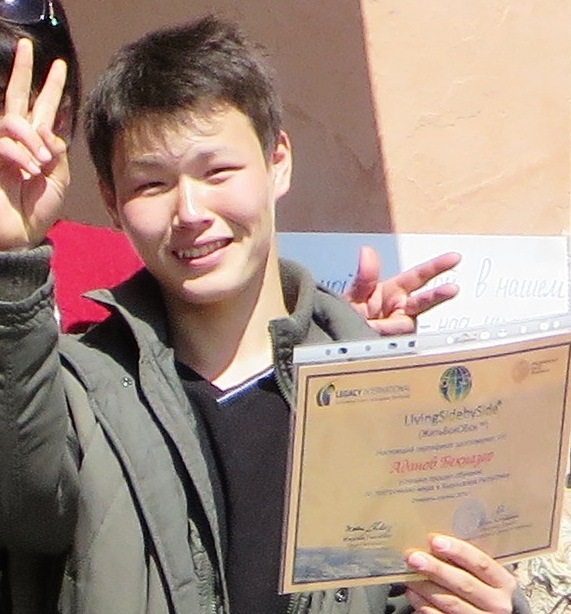
What price for instability…
Perhaps the greatest lesson we can learn from recent history is the high price that the human community pays for unstable inter-religious, inter-racial, and inter-ethnic relations. Positive relations across boundaries of difference are not accidental. Effort and education are required, especially education of those who will one day shape society: our children and youths.
A young person who learns to respect diversity will make different choices -- and thus different contributions -- than one who does not. An individual trained to use dialogue to address conflicts (be they social, ethnic, religious, racial, or personal) is better prepared to select diplomacy, rather than violence and war, as a problem-solving approach later in life. One who believes that understanding and respect are possible, despite differing perspectives, will draw upon a broader range of resources and capacities including helping those less fortunate especially when stereotypes are recognized and overcome.The rewards for human relations training can be immense: tolerance, kindness, cooperation. The price for not educating the next generation is clear -- in Africa, the Balkans, the Caucasus, Central Asia, Northern Ireland, the Middle East, the U.S., and elsewhere.
The Goal of inter-ethnic, inter-racial, and inter-religious tolerance training
Tolerance is the capacity to acknowledge and understand the differences that distinguish individuals from each other or one group from other groups. Tolerance means respecting the natural rights of people to be different from one another, and knowing how to live together with mutual respect among people who hold different values, customs, and ways of life.
What is LivingSidebySide®?
“LivingSidebySide”® (LSBS) is a peace building programme developed by Legacy International (LI), a U.S. not for profit, non-governmental organization. It targets directly six of the 17 UN Sustainable Development Goals: 3. Good health and well-being, 4.Quality Education, 5.Gender Equality, 10. Reduced inequalities, 16. Peace, Justice, and Strong Institutions, and 17. Partnerships for the Goals.
LivingSidebySide® fosters inter-ethnic, inter-religious, inter-racial understanding, leadership, and conflict resolution skills among youths facing troubled circumstances in countries that have experienced recent strife. The concept, methodology, and content were developed through decades of working with mixed US and international groups (Israelis and Palestinians, Northern Irish Protestants and Catholics, various Nigerian groups, and Croats, Muslims, and Serbs from Bosnia and Herzegovina). LivingSidebySide® (36-40 hours) focuses on: 1) increasing awareness; 2) stimulating the discovery of shared values and goals; 3) developing familiarity, empathy, and trust, and 4) gaining concrete conflict prevention/resolution skills and applying them in action.
Initial Results of the External Evaluation show dramatic changes of attitude and behaviour
Using LSBS for 30 years provided positive anecdotal results. For the first time, a pilot project in the Kyrgyz Republic utilizing 1200 students (600 treatment and 600 control students) from conflict areas in three southern regions with the collaboration of the Ministry of Education, Academy of Teacher Training, local school administrators, teachers, and parents. Initial results by the Stockholm International Research Institute include:
- Positive changes in teacher and student attitudes and behaviour
- Improved relations among family siblings
- Conflict prevention and resolution practiced
- Examples of positive, confident, and inspired students wanting to help others less fortunate
- Academic improvement
- 10,000 beneficiaries of social projects designed and implemented by 553 students
Two Case Studies
Timur, age 16, was quiet, closed, lacked confidence, missed classes and was not interested in school. After participation stated: “If you want to change the world, you need to become the change you wish to see”. He learned to use good listening, mediation, and transformational thinking skills in order to resolve conflicts. He has become a leader with self-confidence: “Our future is in our hands…I have faith in the rightness of peace and wish to solve problems fairly”.
Beknazar, age 16, had a history of deep conflict with his father, refusing to respond to any communication attempt. After completing the conflict management plan of lesson 13 of the LivingSidebySide® Peacebuilding program, he devised a plan to improve communication and believes that he now can negotiate with his father and alleviate problems between them. He stated: “It is not good to give into feelings. Rather, it is necessary to approach each act after careful consideration”.
Other examples include inclusive attitude transformation related to persons with disabilities, solving conflicts, and choosing projects that help poor people.
Lessons Learned and Recommendations
The alpha version of curriculum was in Russian and the teacher teams helped to explain nuances at times. The beta version will be in Kyrgyz and Uzbek additionally, and a few concepts will be simplified.
This model prepares the next generation with confidence and hope --leaders who respect ethnicities, religions, genders, and races, and who seek to solve problems whether it be poverty, hunger, or climate change, a few of the many problems facing our planet.
For more information and examples please visit our website.
Final results will be available Fall 2016, contact marlene@legacyintl.org
 Welcome to the United Nations
Welcome to the United Nations